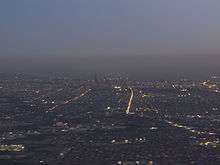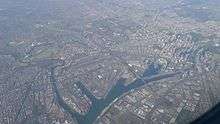Geography of Melbourne



Melbourne, the capital city of Victoria, Australia, is situated on the southeastern fringe of the Australian landmass and in the southern central part of the state. Melbourne covers an area of approximately 8,694 km². The city itself stands in a region of alpine forests known as the High Country. The city and metropolitan areas of Melbourne also spans along the lower stretches of the Yarra River. Towards eastern Melbourne is the low-lying mountain ranges known as Dandenong Ranges, 35 km east of the city.
Melbourne extends along the Yarra River towards the Yarra Valley and the Dandenong Ranges to the east. It extends northward through the undulating bushland valleys of the Yarra's tributaries—Moonee Ponds Creek (toward Tullamarine Airport), Merri Creek, Darebin Creek and Plenty River—to the outer suburban growth corridors of Craigieburn and Whittlesea. The city reaches south-east through Dandenong to the growth corridor of Pakenham towards West Gippsland, and southward through the Dandenong Creek valley, the Mornington Peninsula and the city of Frankston taking in the peaks of Olivers Hill, Mount Martha and Arthurs Seat, extending along the shores of Port Phillip as a single conurbation to reach the exclusive suburb of Portsea and Point Nepean. In the west, it extends along the Maribyrnong River and its tributaries north towards Sunbury and the foothills of the Macedon Ranges, and along the flat volcanic plain country towards Melton in the west, Werribee at the foothills of the You Yangs granite ridge and Geelong as part of the greater metropolitan area to the south-west.
Geologically, it is built on the confluence of Quaternary lava flows to the west, Silurian mudstones to the east, and Holocene sand accumulation to the southeast along Port Phillip. The southeastern suburbs are situated on the Selwyn fault which transects Mount Martha and Cranbourne.
Melbourne's major bayside beaches are located in the south-eastern suburbs along the shores of Port Phillip Bay, in areas like Port Melbourne, Albert Park, St Kilda, Elwood, Brighton, Sandringham, Mentone and Frankston although there are beaches in the western suburbs of Altona and Williamstown. The nearest surf beaches are located 85 kilometres (53 mi) south-east of the Melbourne CBD in the back-beaches of Rye, Sorrento and Portsea.[1][2]
See also
References
- ↑ Russell, Mark (2 January 2006). "Life's a beach in Melbourne". Sydney Morning Herald. Retrieved 29 September 2008.
- ↑ "BEACH REPORT 2007–08" (PDF). epa.vic.gov.au. Retrieved 29 September 2008.